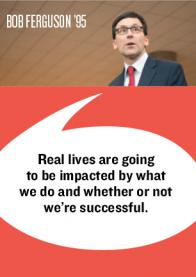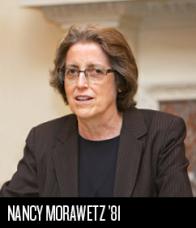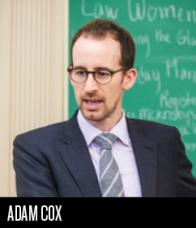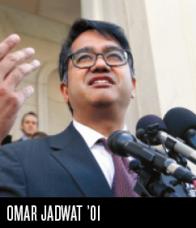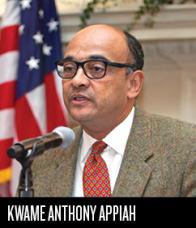The battle over immigration is about law and policy—and people.
BY MICHAEL OREY
GRAPHIC ADAPTATIONS BY ELEANOR DAVIS
When in 1780, at the age of 19, Albert Gallatin left his native Switzerland for America, it was in pursuit of what so many others coming here have sought: the chance to build a new life in a land of seemingly limitless possibility. Highly educated and steeped in Enlightenment thinking, Gallatin found himself steadily drawn into the Pennsylvania politics and then onto a national stage. During his rise, Gallatin’s Federalist opponents used his immigrant status against him, once to disqualify him from serving as a US senator, and later to label him a “Frenchman,” insinuating that he was an agent of France at a time of US-French tensions. Nonetheless, Gallatin went on to serve as secretary of the treasury under Presidents Jefferson and Madison and then as a distinguished diplomat. In 1830 he became one of the founders of New York University and was a champion of its goal of offering education to all, regardless of religion, national origin, or social background.*
More than 200 years after Gallatin’s arrival in America, his experience seems particularly resonant. Throughout US history, questions have been raised about how welcoming the country should be of immigrants and what kind of danger some may present, and Donald Trump made such concerns a focal point of his campaign and his presidency. NYU, meantime, exemplifies the extent to which immigrants are integral to the fabric of our society. University President Andrew Hamilton and Law School Dean Trevor Morrison hail from Britain and Canada, respectively, and a significant portion of faculty, administrators, students, and alumni come from countries around the globe. (See the graphic portrayals of four from the Law School by clicking on the illustrations below.)
Then there is Gallatin’s dedication to public service, which has lived on as institutional commitments of both the University and the Law School since their inception. A prime example: work done by the Law School’s Immigrant Rights Clinic (IRC), co-taught by Professors of Clinical Law Alina Das ’05 and Nancy Morawetz ’81. For two decades, IRC students have represented individuals—defending against deportation or challenging detention, for example—and worked with other organizations to pursue advocacy campaigns, legislation, and litigation to broadly advance immigrant rights. The IRC’s impact has also been greatly magnified by the large number of its alumni who have gone on to take positions in (and in a number of cases found and lead) other clinics, advocacy organizations, and government offices dedicated to the same cause.
President Trump’s executive orders on immigration drew immediate legal challenges from a number of Law School graduates—among them Das; Omar Jadwat ’01, director of the Immigrants’ Rights Project at the American Civil Liberties Union (ACLU); and Washington State Attorney General Bob Ferguson ’95—and in short order they won court rulings staying enforcement of the travel bans. The suddenness with which the first order in particular had been implemented threw the lives of thousands of travelers and their friends and family members into chaos, and the stays offered immediate relief. In June, the US Supreme Court ruled that part of a revised travel ban could go into effect and said it would hear arguments on the lawfulness of the ban in October. Reflecting on this litigation, Ferguson says it serves as “an important reminder of the massive impact the law can have on a deeply personal level for many thousands of people around our country....Yes, we’re arguing constitutional principles or procedural aspects of any particular litigation, but we always remember that real lives are going to be impacted by what we do and whether or not we’re successful. And that is why I went to law school, honestly.”
A HISTORY OF CONCERN
Concerns about unfair targeting and severe treatment of immigrants arose well before the ascent of Trump. Morawetz founded the IRC in 1999 in response to a comprehensive immigration overhaul passed three years earlier under President Bill Clinton. The new laws “were extremely complicated and harsh,” says Morawetz, and “remain the essential architecture for immigration enforcement” today. During a roundtable discussion at the Law School in the spring of 2009—just after the end of President George W. Bush’s administration—Morawetz and others expressed deep concern about the multitude of people who had been deported or held in immigrant detention over the previous decade, as well as an enforcement dragnet purportedly targeting dangerous criminals and terrorists that primarily swept up those who were neither.
But as the Obama administration got under way, it disappointed immigrant advocates by keeping many of the practices in place. In fact, in three cases heard by the US Supreme Court during its 2016–17 term, Das, Morawetz, and Professors Adam Cox and Mitchell Kane contributed to amicus briefs challenging a variety of immigration detention and deportation practices—all of which were defended during Obama’s final months in office by his solicitor general. (Kane, the Gerald L. Wallace Professor of Taxation, was on sabbatical and looking to perform some pro bono work, so he teamed up with Morawetz on one of the briefs. Several students and alumni pitched in on briefs as well: Terry Ding ’18, Anthony Enriquez ’13, Rachel Levenson ’18, and Rhidaya Trivedi ’17.)
Still, few would dispute that things became dramatically different in the Trump administration. It began with candidate Trump's pronouncements during the presidential race, including a statement on his campaign website calling for “a total and complete ban on Muslims entering the United States until our country’s representatives can figure out what’s going on” and comments to the media such as, “We’re having problems with the Muslims, and we’re having problems with Muslims coming into the country.”
Trump also accused the Mexican government of “forcing their most unwanted people into the United States,” including rapists and killers. His call for a wall along the US-Mexico border quickly established itself as “this rhetorical device to further separate us and to further create this divide between immigrants and everyone else,” says Claudia Carvajal Lopez ’18, who trekked across the desert from Mexico to the US when she was four. “It was very disheartening to see the way he would talk about it and his supporters rallied behind it, and it is now viewed as a way to discriminate and harass. There are kids at schools chanting, ‘Build the wall!’ as a way to bully Latino kids or Muslim kids, brown kids.”
The rhetoric prompted a shift on another front as well. While there were “a large number of arrests and deportations under the Obama administration,” Morawetz says, “there were limits.” There was, she explains, “an appreciation of how bad it would be to have full implementation of enforcement—it was a recognition of the central role of prosecutorial discretion.” That changed under Trump. “Simply by calling for a crackdown in speeches, interviews, and broadly worded executive orders,” Morawetz observes, “Trump signaled to immigration and border protection agents that they could and should engage in more aggressive enforcement.” Eventually, some of President Trump’s proclamations were also translated into directives by Immigration and Customs Enforcement (ICE) leadership.
At a presentation to NYU Law alumni at Reunion weekend in April, just as the president was completing his first 100 days in office, Morawetz documented changes that were already evident—ICE arrests were up 32 percent from January 20 to mid-March over the same period in 2016, for example, and the number of arrestees with no criminal records had more than doubled. President Trump, in short, could significantly tighten laws governing immigration without Congress taking any action.
This came as no surprise to Cox, who is the Robert A. Kindler Professor of Law. In 2009, he and Yale Law Professor Cristina Rodríguez published an article outlining how structural changes to immigration law during the second half of the twentieth century, combined with congressional deadlock, had resulted in the president being the nation’s principal immigration policymaker. That continued to be the case under Presidents Obama and Trump, Cox says, observing that for the Trump administration “it’s actually in some ways easier, because their vision for immigration enforcement is one that is shared in significant respects by a lot of the line-level enforcement bureaucracy.” (The ICE union endorsed candidate Trump.) Cox and Rodríguez are updating and expanding their analysis for a forthcoming book.
Other scholarship by Cox that has renewed salience now is a 2014 empirical study of the Secure Communities immigration enforcement program, which led to the detention and deportation of hundreds of thousands of people. The study (co-authored with Thomas Miles of the University of Chicago Law School) concluded that the program had not served its central objective of making the country safer, since it led to no meaningful reductions in crime. The Obama administration discontinued the program, but the current administration reinstated it in January.
EXECUTIVE ORDERS, JUDICIAL RESPONSES
Even before Trump took office, the NYU community began planning for a changed environment. As a onetime student in, and now co-teacher of, the IRC, Das had long represented clients from outside the University facing detention and deportation, but says she never had to worry about NYU students. While undocumented immigrants had enrolled at both the University and the Law School, she says that reprieves offered by programs like Deferred Action for Childhood Arrivals meant they had not been targeted with “the onslaught of enforcement tactics that I’ve seen many of our clinic clients face.” Her concerns on that front changed with the election and broadened to include Muslim students.
In late November, Das helped organize a “know your rights” teach-in for the University community that more than 650 people attended. “But,” Das says, “it was clear from the kind of questions we were receiving that we needed to do more.” As 2016 drew to a close, the University began looking for solutions. At the Law School, Dean Morrison explored possible steps. Das came to him with the idea of a “rapid response apparatus,” and out of that was born the NYU Immigrant Defense Initiative (IDI), established to assist NYU students and staff at risk of deportation. There had been, recalls Das, “this overwhelming sense of ‘What can we do? What should we do?’ and then a sense of, ‘Well, these solutions start at home.’”
IRC students conduct initial screenings of individuals seeking help from the IDI and may refer those needing representation to Wilmer Cutler Pickering Hale and Dorr, which, in an arrangement worked out by Morrison, agreed to take the cases on a pro bono basis.
On Friday, January 27—five days after the IDI was announced University-wide—President Trump issued his first executive order on immigration. Temporarily barring entry into the US by individuals from seven predominantly Muslim nations, and by all refugees, the action quickly drew a number of members of the NYU Law community to the front lines.
On Saturday, University Provost Katherine Fleming emailed Das about a situation unfolding at John F. Kennedy International Airport (JFK). US Customs and Border Protection (CBP) had detained a PhD student trying to return to NYU from her native Iran after winter break. CBP agents were telling detainees that they had to withdraw their applications for admission to the US and take the next available flight to the country they came from. If they refused, CBP would seek an expedited removal order with a five-year ban on returning to the US and place them on the next flight out on the airline they came on.
From her Brooklyn home, Das worked the phones and began drafting a habeas petition to challenge the student’s detention as unlawful. In the early evening, laptop in hand, she got in a taxi and headed to JFK. Arriving at the airport, she recalls, she encountered “something that I never thought I would see in my lifetime.” At least two dozen individuals had been detained pursuant to the executive order. Their family members, some broken down in tears, were clustered in the arrivals area trying to find out what was happening, fearing that their loved ones might be deported, and knowing, Das says, “that it was essentially based on religion.” Protesters massed outside terminals, phalanxes of police in riot gear blocked building entrances, and the CBP was not allowing detainees to speak to attorneys.
Trump’s executive order also sent Jadwat from the ACLU’s Immigrants’ Rights Project springing into action. “There had been rumors this order was coming,” says Jadwat, who is also an adjunct professor at the Law School. “We had been strategizing about ways to challenge it legally. But our strategy was for a situation that was not as fast-moving and chaotic.” Reports of CBP detentions at airports began coming in on Friday evening, and Jadwat and his team worked through the night, filing an emergency motion in federal court in Brooklyn on Saturday. At the conclusion of a hearing that evening, US District Judge Ann Donnelly of the Eastern District of New York issued an order staying the immigration ban nationwide, the first of several such rulings from federal courts.
Judge Donnelly’s order still needed to be communicated and enforced, and Das remained at JFK, working with others through the night to get CBP agents to stop putting people on planes. Her client, the PhD student, was released at about 10:30 Sunday morning, but Das didn’t head home until late afternoon, when other detainees she had been assisting had been freed.
On the other side of the country, Washington State Attorney General Ferguson and his staff engaged in their own weekend work marathon. With a lawsuit led Monday, January 30, in federal court in Seattle, Washington became the first state to challenge the executive order, claiming it violated constitutional guarantees of religious freedom and equal protection. Four days later, US District Judge James Robart of the Western District of Washington also ordered a nationwide stay on the ban.
A revised version issued by the Trump administration in March again drew lawsuits from Jadwat, Ferguson, and others, and it too was stayed by federal courts. Jadwat argued an appeal to the US Court of Appeals for the Fourth Circuit, which in late May upheld a stay issued by a federal district court in Maryland. NYU led amicus briefs in support of suits led by Ferguson and the State of Hawaii. Citing NYU’s mission statement, the University wrote: “NYU is deeply concerned that the executive order will have a significant adverse impact not merely on its numerous current and prospective international students and scholars, but on the ability of the University as a whole to fulfill its mission as a global educational institution for all of its constituents, ‘fitting for all and graciously open to all.’”
IN SEARCH OF COMMON GROUND
As is the case with other policy areas, President Trump’s forceful statements and actions on immigration can provoke equally strong responses. But the sharpness of the exchanges, and the breadth of divide they imply, can obscure areas where Americans might find common ground.
Many would agree, for example, that countries have a right to control their borders. “I don’t think there’s anything wrong in principle with the idea that you don’t let everybody in,” says Professor of Philosophy and Law Kwame Anthony Appiah, who was born in Britain and raised in Ghana and has explored cultural, national, and religious identity in his scholarship. “That’s part of what it is to have nations, and as long as distinctions are based on permissible reasons, it’s the task of a democracy to figure out what to do about inclusion.” Permissible reasons, he is quick to add, do not include those that discriminate against people based on their sex, race, or religion, and nations have a moral and legal obligation to admit asylum seekers—people forced to flee their home countries due to fear of persecution.
While Appiah, who became an American citizen in 1997, has no doubt that immigrants provide a massive overall economic benefit to the US, he allows that some people might be better off if they didn’t face competition from immigrants. But, he notes, if incomes are depressed because employers can pay poor immigrants on the cheap (in some cases in violation of wage laws and other labor protections), his favored solution is not to blame immigrants, but to assure that all workers earn a decent income. As for the millions of immigrants who are here illegally, Appiah says, a country is within its rights to expel them, but here too he advocates a different approach: giving them a chance to legalize their status. “A decent society,” he says, “seeing people embedded and interdependent with us, should want to take away the fear of sudden extraction from the life they know.”
Cesar Francia ’14 moved from Caracas, Venezuela, to Miami when he was 14. Following last fall’s election, he began reading Hillbilly Elegy: A Memoir of a Family and Culture in Crisis, J. D. Vance’s chronicle that illuminates the plight of the white working class in Appalachia and the Rust Belt. “I’m in the business of ‘How can we see each other as people?’ and ‘How can we connect as people?’” Francia says. One task for immigrant advocates who hope to bridge the divide, he says, is “fact correction”—making sure people have accurate information about the role immigrants play in American society. But, Francia adds, “We also need to have as much storytelling as possible to share aspects of our community to try to help people understand who we are—you know, to put a human face on this issue.”
*Gallatin: America’s Swiss Founding Father, Nicholas Dungan, New York University Press (2010)
Michael Orey is public affairs director for the Law School.
Ferguson photo: Washington State Attorney General's Office/Ian Couch | Jadwat photo: Associated Press/Steve Helber
Posted September 1, 2017
